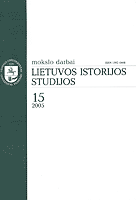VILNIAUS UNIVERSITETO ISTORINĖS ATMINTIES MODELIAI IR PRAEITIES REPREZENTACIJOS XIX-XX AMŽIUJE
MODELS OF HISTORICAL MEMORY AND PAST REPRESENTATIONS OF VILNIUS UNIVERSITY IN THE 19–20TH CENTURIES
Author(s): Alfredas BumblauskasSubject(s): History
Published by: Vilniaus Universiteto Leidykla
Summary/Abstract: The article aims at presenting the topic of Vilnius University in different ideologically and politically conditioned models of historical memory of the 19th and 20th centuries. The analysis is based on Jörn Rüsen’s theory of historical culture. The article focuses on the representational forms of Vilnius University of the past times, such as anniversaries (1828, 1929, 1979, 2004), monuments, commemoration galleries, naming of the courtyards and halls of the University, commemorating both the said anniversaries and marking other occasions, as sources of historical memory. During different periods of development – be it the Russian period (1795–1832), the Polish period (1919–1939), the Lithuanian period (1939–1940, 1941–1943) or the soviet period (1940–1941, 1944– 1990) – Vilnius University became the arena for the dominance of nationalistic, authoritarian and totalitarian ideologies. Hence it is worthwhile to adjust the historiographic images that fail to deliberate the significance of these factors to the historical memories, fail to embrace the conflicts of the memories and portray the past of Vilnius University merely from a perspective of a single nationalistic historical consciousness. On the other hand, the different developmental periods witnessed not the “pure” nationalistic models of historical memory – such as the “Polish",“Russian”, “Lithuanian”, as well as the communist model – but rather a compromise of different models. The shifts in the historiography at the juncture of the 20th and 21st centuries enable us to perceive the Great Duchy of Lithuania as a country of East Central Europe, bound to make a leap towards europeanization. The price of Europeanization for Lithuania was polonisation of its culture. This interpretation is contrary to the traditional Lithuanian model of historical memory; it sheds a different light on the Lithuanian Poles and phenomena of Polish culture (including Vilnius University), interpreting them as the self-identity of Lithuanian culture. Yet again, changes in historiography make it possible for us to start perceiving and interpreting Vilnius University within the context of the universities of East Central Europe and Jesuit universities. In the 16th-18th centuries Vilnius University was the most eastwards forwarded voorposten in the network of eastern universities, having no counterparts in terms of the area of its impact. Such an understanding and interpretation of the old Jesuit university adjusts the Russian (and partially the Lithuanian) model of historical memory, shaped since the epoch of Enlightenment. The above said enables drawing closer different models of historical memory – be them secular and confessional, Lithuanian and Polish – and creates the prerequisites for a multiperspective historical consciousness and historical memory.
Journal: Lietuvos istorijos studijos
- Issue Year: 2005
- Issue No: 16
- Page Range: 48-64
- Page Count: 17
- Language: Lithuanian

